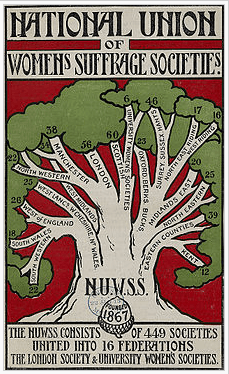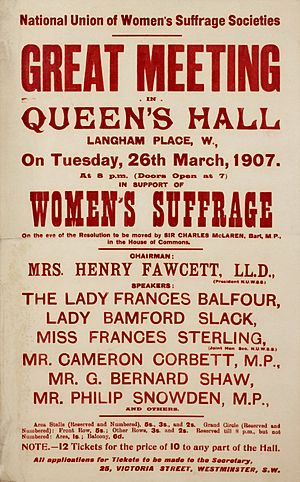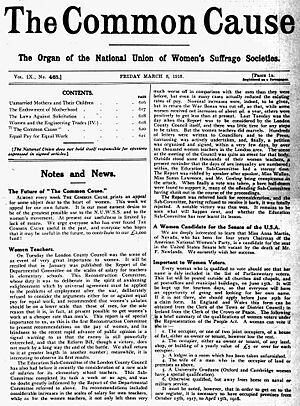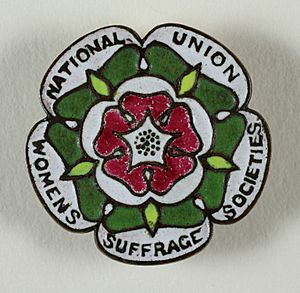National Union of Women's Suffrage Societies facts for kids
 |
|
| Predecessor | National Central Society for Women's Suffrage and the Central Committee of the National Society for Women's Suffrage |
|---|---|
| Successor | National Union of Societies for Equal Citizenship |
| Formation | 14 October 1897 |
| Dissolved | 1919 |
| Headquarters | 22 Great Smith Street, Westminster |
| Leader | Millicent Fawcett |
The National Union of Women's Suffrage Societies (NUWSS) was a group formed in 1897. It brought together many smaller groups across the United Kingdom. Their main goal was to get women the right to vote. People often called them 'suffragists'. This group was different from the 'suffragettes', who used more forceful methods. In March 1919, the NUWSS changed its name to the National Union of Societies for Equal Citizenship.
Contents
How the NUWSS Started and What They Did
Leaders of women's suffrage groups met in Birmingham in 1896. They wanted to combine their separate groups into one big organization. The NUWSS officially started on October 14, 1897. It was formed by joining two older groups that had split up earlier.
The groups came together under the leadership of Millicent Fawcett. She was the president of the NUWSS for over twenty years. Local groups were part of the NUWSS but could still make many of their own decisions. By 1903, there were 16 such groups. The NUWSS allowed men to join, but only women held leadership roles.
The NUWSS believed in peaceful and legal ways to achieve women's right to vote. They worked to introduce new laws in Parliament. They also held many meetings to explain their goals to people. Their main aim was to get women the right to vote on the same terms as men. At that time, men had to own property to vote. This made the NUWSS's goal a bit tricky for some working-class people.
In 1903, a new group called the Women's Social and Political Union (WSPU) formed. This group, led by Emmeline Pankhurst and her daughter Christabel Pankhurst, wanted to use more aggressive actions. They were known as the "suffragettes." Even after this split, the NUWSS continued to grow. By 1914, it had branches all over the country. It had about 54,000 members. Most members were middle class, but some were working class.
Until 1906, the NUWSS focused on talking to Parliament. They supported new laws that would give women the right to vote. For the 1906 election, they worked to get candidates who supported women's suffrage. They got 415 candidates to promise their support. The NUWSS also organized its first big outdoor march. This march, on February 9, 1907, became known as the Mud March.
In April 1909, the NUWSS started its own newspaper called The Common Cause. Helen Swanwick was its editor. Margaret Ashton helped pay for the newspaper by selling her house.
By 1910, some suffragists in the NUWSS started to doubt if just asking Parliament was enough. However, Millicent Fawcett said in 1911 that their movement was "like a glacier; slow moving but unstoppable."
In 1913, the NUWSS organized a long walk to London. This "pilgrimage" was started by Katherine Harley. It was meant to show that the suffragists were peaceful and followed the law. This was a contrast to the more aggressive actions of the suffragettes. The walk ended with a huge gathering of 50,000 people in Hyde Park. They hoped that the Prime Minister, Asquith, would meet with them. He did meet them on August 8, but it did not change government policy.
The main office of the NUWSS was at 22 Great Smith Street in Westminster, London. This was their home from 1910 to 1918.

NUWSS and Politics
Before July 17, 1912, the NUWSS did not support any single political party. Instead, they supported individual candidates who believed in votes for women. A proposed law in Parliament, the Conciliation Bill of 1911, changed this. This bill had a lot of support but did not pass because there wasn't enough time given to it. The government at the time relied on another party for support. They wanted to focus on a different law instead.
The Labour party, from 1903, was connected to the Liberal party. Its leaders had different ideas about women getting the right to vote. However, in 1913, the Labour party agreed to oppose any voting law that did not include women. This happened after a campaign by suffragists in northern England. The Labour party consistently supported women's right to vote before World War I.
Millicent Fawcett, who was a Liberal, became very frustrated with her party's delays. She started helping Labour candidates against Liberals in elections. In 1912, the NUWSS created a special committee called the Election Fighting Fund (EFF). This committee, led by Catherine Marshall, supported Labour. In 1913–14, the EFF helped in four special elections. Labour did not win any, but the Liberals lost two. By working with Labour, the NUWSS tried to pressure the Liberal party.
The NUWSS During World War I
When World War I started, the NUWSS was divided. Most members supported the war, but a smaller group was against it. Millicent Fawcett tried to keep the organization together. She did not want the NUWSS to break apart over the war.
In April 1915, a suffragist from the Netherlands, Aletta Jacobs, invited suffrage members from around the world to a meeting. This meeting was called the International Congress of Women. Because of this, some NUWSS members, like Catherine Marshall and Helen Swanwick, left the organization.
During the war, the NUWSS focused on helping with relief efforts. They put less effort into campaigning for votes for women. They set up a system to help people find jobs. This was important because many men were away fighting. The NUWSS also paid for women's hospital units. These units had only female doctors and nurses. They served in France during World War I, like the Scottish Women's Hospitals for Foreign Service (SWH).
The NUWSS supported a new bill about women's right to vote. This bill was agreed upon by a special group of politicians. Even though it did not give women completely equal voting rights, the NUWSS still supported it.
What Happened After World War I
In March 1919, the NUWSS changed its name to the National Union of Societies for Equal Citizenship. Eleanor Rathbone became its new leader. The group continued to work for equal voting rights for women. This goal was finally achieved in 1928. That year, the Representation of the People (Equal Franchise) Act gave all women the right to vote on the same terms as men.
The records of the NUSEC are kept at the Women's Library in London. Many interviews about the suffrage movement also mention the NUSEC. For example, Helen Fraser, a Scottish suffragist, talked about the group's structure. Gertrude Horton discussed her role and how the organization worked. Vera Douie shared details about the NUSEC's goals. Margery Corbett Ashby spoke about her time as NUWSS secretary and the leaders.
In 1928, the NUSEC split into two new groups. One was the National Council for Equal Citizenship, which worked on other equal rights campaigns. The other was the Union of Townswomen's Guilds. This group focused on education and welfare for women.
Important Members of the NUWSS
- Margaret Aldersley
- Catherine Alderton
- Betty Balfour
- Florence Balgarnie
- Anna Barlow
- Annie Besant
- Ethel Bentham
- Vera Brittain
- Elizabeth Cadbury
- Ada Nield Chew
- Margery Corbett Ashby
- Kathleen Courtney
- Lady Florence Dixie
- Millicent Fawcett
- Isabella Ford
- Henrietta Franklin
- Helen Fraser
- Alison Garland
- Sarah Grand
- Katherine Harley
- Margaret Heitland
- Margaret Hills
- Elsie Inglis
- Louisa Lumsden
- Margaret MacDonald
- Chrystal Macmillan
- Louisa Martindale
- Catherine Osler
- Beryl Power
- Clara Rackham
- Katherine Raleigh
- Eleanor Rathbone
- Sarah Reddish
- Annot Robinson
- Maude Royden
- Amelia Scott
- Evelyn Sharp
- Nessie Stewart-Brown
- Janie Terrero
- Laura Veale
- Mary Ward
- Edith Grey Wheelwright
- Ellen Wilkinson
- Mary Stocks
Where to Find Records
The old papers and records of the National Union of Women's Suffrage Societies are kept at The Women's Library. This library is part of the Library of the London School of Economics. You can find them under the reference 2NWS. Another collection of NUWSS materials is at the John Rylands Library in Manchester, with the reference NUWS.
Remembering the NUWSS
In 2022, English Heritage announced a special plaque for the NUWSS. This blue plaque was placed at their former headquarters in Westminster. This was the building where they worked just before the Representation of the People Act 1918 was passed. This act gave some women the right to vote.
See also
 In Spanish: Unión Nacional de Sociedades de Sufragio Femenino para niños
In Spanish: Unión Nacional de Sociedades de Sufragio Femenino para niños
- Women's suffrage in the United Kingdom
- The Women's Library (London) – This library has many records about women's right to vote, including the NUWSS archive.
- List of British suffragists and suffragettes
- List of women's rights activists
- List of women's rights organisations
- Timeline of women's suffrage
- Women's suffrage organisations
- Liverpool Women's Suffrage Society






